
The Broughton lumber flume was a 9-mile wooden trough that transported rough-sawn timber (cants) from a lumber mill in Willard, WA to a finishing mill in Hood, WA. The first part of the flume was built in 1913 and ended at Drano Lake. A second flume was constructed between 1921 and 1923. This extended the flume length to the full 9 miles and ended at the Hood mill (near Underwood). When the flume ran across a private residence, it was initially leased. Broughton purchased the flume and right-of-ways in 1923. The flume water originated at the Little White Salmon River and flowed downhill at a rate of approximately 9 miles/hour. Since the flume was nine miles long, it took 55 minutes for a piece of lumber to make the trip from the Willard Mill to the Hood Mill. The flume transported about 130,000 to 150,000 board feet/day. This is enough to build about 12 homes. The flume was very stout. It had supports and legs every 4 feet. The flume was constructed out of 16-foot long 2 x 14" tongue & groove Douglas fir boards. The 2 x 14" boards were 2 inches thick which made the troughs tough and strong. Cedar lumber was used for the legs and supports because it was rot resistant. The flume was v-shaped on the bottom and the water ran about 2-feet deep. In a few places (road crossings), the flume was made of metal (3/8 inch steel plates welded together). The flume was a money saver for many years because it solved the problem of transporting the lumber down a 13-mile winding road by truck.
As you read thru this article, you will see pictures of the flume in different stages of its life. At the end of this blog, you will see time lapse photos showing the deterioration of the flume.

The flume descended a total elevation of about 1000 feet over its nine-mile course and at some points was over 80 feet off of the ground. Over the last 4 miles, the flume was built along the cliff side of the Columbia River. The flume was an attraction for both people and animals. It was not uncommon for the flume crew to find porcupines, deer and rattlesnakes along the trough.
Flume Facts
The Broughton Lumber Company

The flume system worked so well that the upper mill (Willard) would start work at 7am and the lower mill (Hood) would start work at 8am so the lumber would be there waiting for them.

Hood, Washington
The town of Hood (est population 20) is the current location of the Broughton Lumber Co. It is located just west of Underwood. It currently has about 8 homes and the empty lumber company. The lumber co. has the feel of a "ghost town". It is currently being evaluated for a wind surfing resort.

The flume could handle cant lengths of up to 40 feet. Anything longer was usually trucked down to the lower mill. A dam built by the Pacific Power and Light Co. on The Little White Salmon River above Willard, WA provided the head (water propulsion) for the flume.

The flume has much historical significance. The engineering is impressive. The cost-effectiveness at the time of operation is equally impressive. It was also the last functioning lumber flume of it's type in the United States and the longest working flume in the world when it closed down on Dec 19, 1986. The flume was not designed to be water tight and some leakage was normal.
The flume was not designed to be water tight and some leakage was normal.
During times of winter freezing, the flume could have icicles running from the trough to the ground, sometimes of up to 20 feet high. The flume was shut down during severe freezes.
Like much of the lumber industry itself, the flume was ephemeral in nature.
A plaque at Drano Lake on Hwy 14 provides info and pictures about the flume.
End of the Flume
In December of 1986, the flume and the Willard mill were both closed. This happened because the supply of large diameter logs were disappearing. The new age forests couldn't supply the Willard mill with enough timber to make it economical. Other reasons may have included the environmental impact on the Columbia and Little White Salmon River, upkeep on the aging flume and insurance liability reasons. After the flume was shut down, it was dismantled in several critical areas. Some of the flume segments were taken for souvenirs, some pieces were put in museums and parks while the rest was allowed stand and bare the elements (slowly bending to the will of gravity). In May of 2009, I visited the flume and found it to be mostly in ruins. I estimate that in less than 20 years, the flume will be gone, with the exception of the 2 metal structures. If you want to see the flume, do it soon. The longer you wait, the less of it you will see. The Town of Willard
The Town of Willard
Former lumber town. Population 46. The town at one time had the Broughton Lumber Mill, a gas station, 17 company houses and a company store. It was the oldest mill in Skamania County when it closed in 1986. Some of the nicest people you will meet anywhere.
.
Retracing the Flume's Path
The Broughton flume and it's water originated from a dam at the Little Salmon River just north of Willard. Water was gravity fed from the dam into the feeder flume which crossed Lava Creek, ran along Oklahoma St. and then went under Oklahoma St., resurfaced and ran along Flume Rd. towards the Willard mill where it picked up lumber.
From the mill, it crossed under Willard Rd. (Co Hwy 86), went over the Little Salmon River and under Willard Rd. From here, it paralleled a service road (name unknown) where it crossed John Young's Road. The crossing structure was initially made of wood and later was made of metal. After this, it headed south and paralleled Willard Rd. From here, the flume took a SW direction and headed for Chenoweth Rd. It crossed Cook-Underwood Rd with the large green steel span just north of Chenoweth Rd (mile post 8). Next, it paralleled Chenoweth Rd and crossed under this road just before the road ends. This is also the location of the emergency water dump portion of the flume. In addition, this is the half way point of the flume: 4 and 1/2 miles each way to both Willard and Hood. From here, the flume wrapped around the hillside and began it's descent towards the Hood mill. It parallels Hwy 14 and is visible along the cliff above the highway. It can also be seen from across the river on the Oregon side. A good place to see this is Mitchell Point.
.
Restoration and Preservation of the Flume
An organized attempt should be made to preserve some parts of the flume. The 2 metal structures that once crossed the roads are in good shape and will last a long time. The one in Bingen has been repainted recently. The area of Chenoweth seems like a good place for a historical site to preserve part of the flume. It has good access and much of the flume still remains there. A trestle portion of the flume would be a nice tribute, but access and cost may be a problem.

Broughton Flume Time Line
1913 Flume built from Willard to Drano Lake
1916 Harold J Broughton and DM Stevenson operate mill at Willard
1920 Broughton Lumber Company opens
1923 Broughton Lumber Co. buys flume
1923 Broughton Lumber Co. constructs additional 4 1/2 miles of flume to Hood mill
1946 Post war lumber boom
1947 Flume damaged by rock slide caused by goats
1963 Ice storm damages flume in several places
1969 National Environmental Protection Laws enacted
1969 Fire destroys 1/4 mile of the flume
1972 EPA/US Forest Service restricts clear-cutting of forests
1975 Broughton Lumber Co. peaks with 450 employees
Special Thanks to:
Thanks for stopping by!







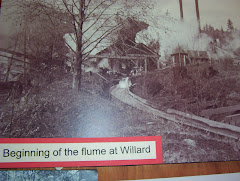



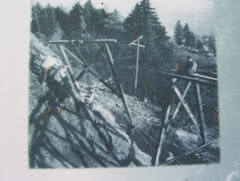







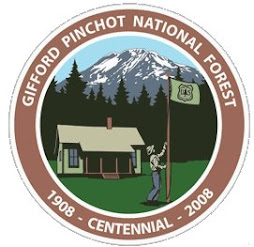








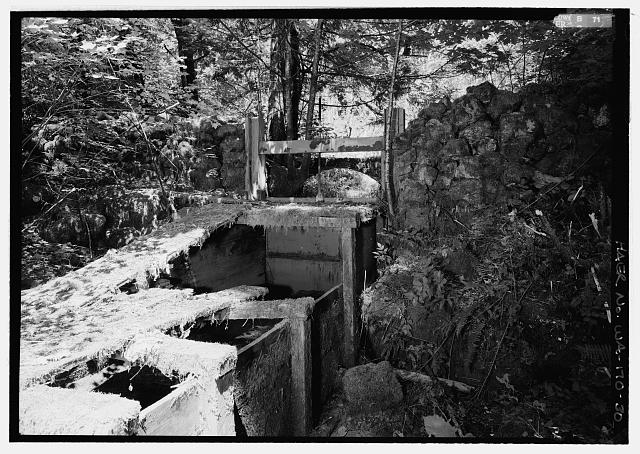

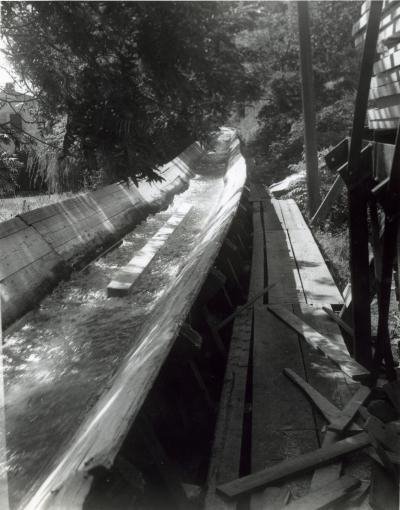





Thank you for this page Jeff! What a wonderful tribute to the town and life I grew up knowing up front and personal!
ReplyDeleteMy Dad worked at the Willard Mill for years, on the weekends it was a big play ground . Even had a few rides on the flume, My oldest brother jerry got his picture taken with Lassie by the flume. We knew everybody at the mill and was always watched. I'll look for pictures of the mill and flume , Thanks for Something that is still Very Dear to My Family and other Familys as Well!!!!
ReplyDeleteMy Great grandfather who started Mill A and Mill B built the very first flume which was eventually sold to Broughton. There were originally 3 flumes and prior to the flumes they floated the wood down the little white to the Billy Drano mill sight. Mill-A made mostly railroad ties and cord wood for stern wheelers.. Thanks so much for the article !!!
ReplyDeleteFascinating article on the Flume! Don Morby, I did not know that about your family history, how awesome to be part of that story.
DeleteYes that was the Drano Flume and Lumber Company that started in 1913 to 1923 until Broughton Lumber Co acquired them.
DeleteFascinating article on the Flume! I was 8 or 9 when Lassie came to the flume for her movie and she was my hero, now I am jealous of Dan's brother! lol..
ReplyDeleteAlso I used to take care of Robert (Bob) Krause when he was in a care home in WS... he used to tell me stories of patrolling and fixing the breaks on the flume. Wish he was still here so I could pick his brain.
This comment has been removed by the author.
ReplyDeleteThis comment has been removed by the author.
ReplyDeleteYou can see the flume in action in the Disney movie Charlie the Lonesome Cougar.
ReplyDeleteYou can see the flume in action in the Disney movie Charlie the Lonesome Cougar.
ReplyDeleteI'm thanking Mr. Pedro for helping me acquire my VA Mortgage loan. It was great receiving my loan of $900,000 USD from this loan lender. My name is Krasimir Todor am Belgian. I got my loan from this reputable loan lender on the 20th of November 2019 and I want to quickly use this medium to tell everyone here that you can acquire any loan from this credible loan company. A VA loan lender is not easy to come by and it must be recommended by the Department of Veteran Affairs. Mr Pedro will give you loans at low-interest rates of 2% rate and very fast. Get your loans at Email: pedroloanss@gmail.com
ReplyDelete